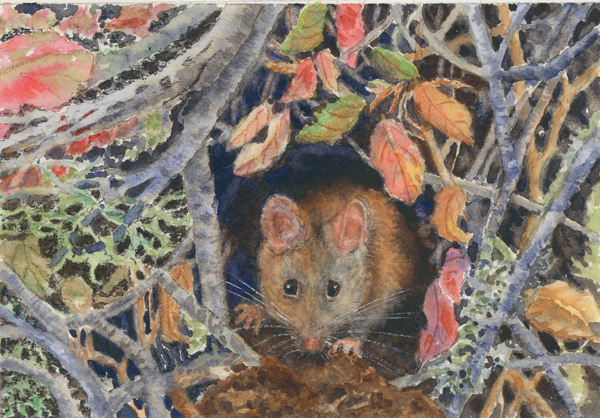
Secrets of the Oak Woodlands: Plants and Animals among California’s Oaks
by Kate Marianchild
Excerpts from the woodrat chapter
“Once upon an epoch, perhaps three million years ago, a storm-swollen stream tugged a log from a section of bank, leaving a mother woodrat and her newborns exposed and shivering with cold. With four babies clinging to her nipples, the mother scuttled away from the stream to the base of a boulder. Using her teeth, she pulled a few dead branches over herself and her infants, warming and hiding them. One baby eventually died of cold and two were eaten by rattlesnakes, but the one who survived imitated her mother and pulled a few sticks over her own babies when they were born a year later.
Scenarios such as this may have been enacted and reenacted multiple times over millennia before house construction “stuck” as a genetically encoded behavior of woodrats. Regardless of when or how it happened, it was a great day in prehistory when the first woodrat decided to build. Her descendants appear to create more elaborate above ground houses than any other mammal in the world besides humans. These structures serve their owners brilliantly and play a keystone role in oak (and other) ecosystems. The two species discussed in this chapter build the most magnificent mansions of all.” (p. 183-184)
“A large, well-built woodrat castle is an architectural wonder––a multilevel complex of rooms, corridors, and terraces that might easily fill a space one thousand times the size of its single owner/occupant. Such a mansion can remain in use for over sixty years as generation after generation keeps adding foliage to the outside and remodeling the inside by chewing out new passageways and rooms. As you start noticing woodrat houses, you will be amazed at the architects’ ingenuity in using whatever building materials are locally available.
Large woodrat dwellings have three or four waterproof sleeping rooms that double as birthing nests and nurseries. Sleeping nests, which are often under logs or rocks in the safest part of the house, have been found to be dry after four days of drenching rain. Lodges also have pantries, leaching rooms, latrine areas, and openings that admit light and air to every level. The occupants line their sleeping nests with soft plant material such as thistledown or finely shredded bark and, clever fumigators that they are, they scatter leaves of California bay laurel around the edges when available. They nibble the outside edges of these leaves to release powerful volatile oils that kill seventy-three percent of flea larvae and other nest parasites. According to scientists, woodrats nibble bay leaves only for fumigation purposes––never for nutrition. A householder will replace used leaves with fresh ones every two to three days.” (pp. 187-188)
